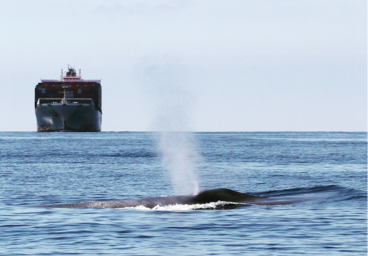Previous Research

Bowhead whale migration changes driven by declines in sea ice
As the Arctic warms four times faster than the rest of the planet, visual, acoustic, and satellite tagging evidence suggests bowhead whales might be changing their migration patterns. We analyzed 11 years of recordings of bowhead whale calls and songs to explore relationship between migration timing and sea ice in the Chukchi and Bering Seas. Fall migration into the Bering Strait and spring migration into the southern Chukchi Sea was strongly tied to sea ice in the Chukchi Sea, while sea ice in the Bering Sea was responsible for how long whales were absent between the southward and northward migration. Since 2013, some whales are remaining in southern Chukchi Sea rather than moving into the northwestern Bering Sea for the winter. Changes to bowhead whale migration could increase the overlap with ships and impact Indigenous communities that rely on bowhead whales for nutritional, cultural, and spiritual subsistence. Read our recent publications in Movement Ecology and Geophysical Research Letters.
Humpback whale distribution relative to prey hotspots
During summer 2018, a line-transect survey for cetaceans and coastal pelagic fish and krill species was conducted over the continental shelf and slope off southern British Columbia and the U.S. West Coast, allowing for an unprecedented large-scale concurrent investigation of predator-prey spatial relationships. We explored the relationship among humpback whales and their primary prey in the region — Pacific herring, northern anchovy, and krill (euphausiid spp.), using generalized additive models to explore the relationships between whale counts on 10-km transect segments and various prey metrics. Prey species were quantified using mean and total prey biomass densities and prey hotspots (segments with mean prey density > 95th percentile of values across all segments) from local to regional scales (number of prey hotspots within 25, 50, and 100 km of each segment), using multiple combinations of prey hotspots. Models using mean or total prey biomass densities on the segments performed poorly, whereas models using hotspot metrics were much more effective at describing variation in in humpback density. Our analysis revealed differences in the distribution and prey availability for two distinct population segments of threatened or endangered humpback whales that forage within the California Current Large Marine Ecosystem. These fundamental findings will inform the conservation and management of humpback whales within an ecosystem-based management framework. Read our publication in Ecological Applications.
Blue whale migration timing
To avoid temporal asynchrony with prey, animals migrating long distances accommodate environmental variability by altering their migration timing. Plasticity in migration timing has been well studied in terrestrial birds and mammals, but less in aquatic animals. This research examines the drivers and timing of blue whale migration across 10 years to and from their Southern California feeding grounds. Passive acoustic data were collected from 2008-2017 at five sites off Southern California using seafloor-mounted recorders, and blue whale "D" and "B" calls were used to define annual arrival and departure dates. Colder integrated sea surface temperatures from the previous feeding season correlated with earlier arrival and greater krill biomass in Southern California, suggesting that blue whales time their arrival to the feeding grounds based on their memory of the past year's conditions knowing that colder waters are a proxy for greater krill biomass. Krill fluctuations also mediated the transition from feeding calls to breeding calls at the feeding grounds. When whales had access to more krill, they ceased D calls and switched over to B calls sooner. However, as climate change increases temperatures, blue whales are arriving more than one month earlier than they were 10 years ago. Longer time on the feeding grounds may alter reproductive timing and success, and by increases the temporal overlap with human activities, will increase the risk of entanglement in fishing gear and ship strikes. Read our publication in Scientific Reports.
Blue whale chronic exposure to vessels
Blue whales are at an increased risk of ship strike at their feeding grounds because of the overlap with heavy ship traffic, but the factors leading to strikes are poorly understood. During close encounters with ships, tagged blue whales performed visible response dives, but only when ships were within 500 m. Because the context that results in whales performing these response dives are unknown, this research investigates blue whale-ship encounters to determine which cues blue whales use to avoid ship strikes. Since 2013, we have collected acoustic and kinematic data from 37 blue whales using animal-mounted tags with our nonprofit partner, Cascadia Research Collective. Using the whale positions from each tag's GPS and ships positions from the Automatic Information System, distances can be calculated to identify periods when a ship and whale were close to each other (<500 m). General additive mixed models are being used in a Bayesian framework to model the probability of a tagged blue whale response dive given the ship's distance, length, speed, exposure time; whale id, sex, behavior, group size, encounter history; and environmental sea state, month, light level, and chlorophyll a. If certain factors of ship-whale encounters help whales successfully avoid ships, or alternatively, put whales at greater risk of a potentially lethal ship strike, this information can be used by managers to reduce the risks of exposure to ships or increase the chances of a successful evasion during a ship encounter. Read one of our publications in Frontiers in Marine Science.